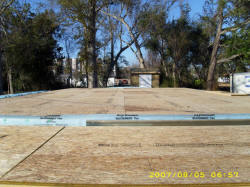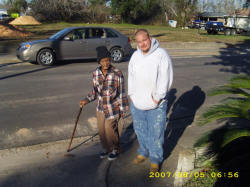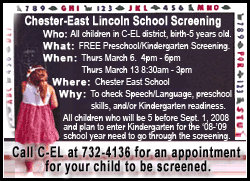 The week the storm hit, I wrote a
couple of checks to those on the front lines of the tragedy.
However, I remarked to my wife at the time that sending money is not
enough when a major disaster strikes. As an American, when something
major happens, it affects all of us. I like to think that our
positive response is one of the things that distinguishes us from
many other countries in the world. Whether I am correct in that
assessment or not, I will go to my grave thinking that Americans
should help Americans when destruction has struck. The week the storm hit, I wrote a
couple of checks to those on the front lines of the tragedy.
However, I remarked to my wife at the time that sending money is not
enough when a major disaster strikes. As an American, when something
major happens, it affects all of us. I like to think that our
positive response is one of the things that distinguishes us from
many other countries in the world. Whether I am correct in that
assessment or not, I will go to my grave thinking that Americans
should help Americans when destruction has struck.Instead,
sometimes the ugly, evil side of human nature turns up. It seems as
if, from the start, lots of people were looking to blame the
government or to wait and depend on the government for immediate and
long-term help. I understand that for some types of help, that is
all you can do. But it also appears to me that as Americans we have
forgotten a few things. Foremost on that list is that we have
forgotten that America is US. So blame the government if you
think that will do any good -- and good luck with that. Or, you can
continue to wait and depend on the government if you think that is
the final answer. To me another thing on the list of forgotten
things is that neighbors are supposed to help neighbors.

So, to start directing this article toward a point, I spent the
first two winters after the storm trying to get to the Gulf Coast.
Isn't it incredible how many things can stand in the way of doing
the right thing? Or at least trying to do something good? I try to
live a life worthy of my calling, so I don't like to embarrass
myself publicly unless it's for a good cause, but I'm embarrassed
that I did not get to the Gulf Coast any sooner than I did. There is
no adequate reason or excuse for it other than I simply dropped the
ball. While it is a regret I will have to live with, I finally made
it there last week, and the following is my report. It is merely a
firsthand, eyewitness account of what I and a small group of
"brothers" found on our rebuilding mission. We went down to help
where we could and to scout out the situation to see if more
volunteers were needed in the future. The following is the account
of our experiences.

First a little history
Hurricane Katrina, a Category 5 hurricane, was formed on Aug. 23,
2005, and dissipated on Aug. 30, 2005. It made landfall on the Gulf
Coast on Aug. 29, 2005. It was the third-strongest hurricane on
record to ever make landfall in the United States. At least 1,836
deaths were attributed to Katrina, and subsequent floods and damage
totals were over $81 billion dollars (Wikipedia).
According to ABC News' Charles Gibson on a Katrina follow-up
story that coincidentally aired last week while we were in the Gulf,
30,000 families totaling 100,000 people are still displaced today!
It was in this setting that we thrust ourselves into the ongoing
rebuilding project last week. One of the organizations that has long
been close to my heart is Habitat for Humanity. Habitat for Humanity
International was founded by Millard and Linda Fuller in 1976. Their
vision was to establish an organization that would help to eliminate
poverty housing and homelessness from the world and to make decent
shelter a matter of conscience and action (those words "conscience"
and "action" really stuck with me, and I never got them out of my
mind). The Habitat organization has built more than 225,000 houses
around the world that have provided 1 million people in more than
3,000 communities with safe, decent and affordable housing (www.habitat.org).

Why the Mississippi Gulf Coast?
Good question. Many of the people in central Illinois who made me
feel worse for not traveling south sooner were going to the New
Orleans area. With over 50 percent of the storm's damage directed at
that area, I can see why so many wanted to go help there. While I
wanted to go and help there, my heart kept turning to the
Mississippi Gulf Coast. Some of you know that my friend Craig
Zastrow (a former Lincoln resident) and I travel to the NCAA Final
Four together every year. One year when the finals were in the
Superdome in New Orleans, we decided to stay in Biloxi, Miss. I
can't speak for Craig, but that trip was one of the best Final Four
memories I have ever had. The people were friendly, the food was
awesome, and the golf was spectacular. So, when I saw that this
storm had decimated the Biloxi area, I just wanted to go back and
make a small return payment to a community that I felt so much for.

As you can imagine, many relief organizations have been getting
it done in the Mississippi Gulf Coast area since just days after the
tragedy -- Habitat for Humanity chief among them. In fact, in a
great display of unity, two counties -- Harrison and Jackson
--merged to form the Habitat for Humanity of the Mississippi Gulf
Coast in January of 2007. This group has amazingly completed or has
under construction some 170 homes. Their plan is to build 800-1,000
homes by 2012 (www.hfhmgc.org).
And with a mission or vision statement like "Building houses,
building hope," how could you go wrong!
So, since the Biloxi area had an outlet for service, it was a
"no-brainer" for me to set up a trip to the Habitat for Humanity of
the Mississippi Gulf Coast! With that in mind, I began to organize
my plan. I told Melinda that this winter I just had to go there. She
knew my heart and encouraged me to do so. I also told her that I was
going even if I couldn't get anyone else to go with me. I began
corresponding with the Habitat group and a lady by the name of Loren
Moylan in the volunteer services office. Loren is extremely
organized and a great encourager. She is a consummate professional
who dotted all the "i's" and crossed all the "t's." She made our
trip planning so easy that even a dope like me could figure it all
out. At first we had about 12 people in our group. Seven of them
kept having the same obstacles cropping up that I had fielded the
previous two winters. One guy's wife was due with a baby any day;
another guy got a job promotion and didn't feel like the timing was
good for him to get away; and on and on the hurdles came. When we
loaded the van and headed for the Chicago O'Hare airport, there were
five of us making the trip. As it turned out, a smaller group was
much better logistically for this scouting operation.

I have met lots of wonderful people during my 1 1/2 years in
Beloit, Wis. Three of those gentlemen were coaxed into going on this
adventure. Brian Cain and Jason Taylor, who are construction
contractors with Cain-Banker Construction, and Mark Rand, who is an
insurance agent with Alongi-Santos Insurance Agency, were willing to
team with me on this endeavor. We were also joined by a gentleman
who played college basketball for me in the middle '90s, Paul "Big
Chief" Davis, who is a financial planner with Primerica. The five of
us loaded the plane and headed for Gulfport, Miss., by way of
Atlanta.
All in all, we would be just five of over 500,000 volunteers who
have worked in the Gulf Coast over the last 2 1/2 years (according
to Gov. Barbour's report at
www.governorbarbour.com/recovery). The report also states that
some 5,320 homes were either built, rebuilt or renovated during this
time. We were anxious to get there and do our small part to help.
Accommodations
Where did we stay, where did we sleep and what did we eat? Again,
good questions. Apparently somehow Habitat hooked up with the
Salvation Army. In the early days right after the storm, someone had
the idea of using Yankie Stadium, the old local high school football
field, as a staging area. In those first few days they used the huge
rooms under the massive sets of permanent bleacher seats as places
to house and feed rescue workers and displaced local residents. As
time went on, it became the place to house and feed Habitat and
Salvation Army volunteers. They also added some bunkhouses, some
porta-potties, etc.

You pay $100 a week for this experience, and that includes your
housing in the dorms and three delicious meals every day of your
stay. You are responsible for traveling to and from your team's work
site every day. You can stay in a hotel or your own RV if you have
one and if that is your preference. A wonderful couple, Bill and
Wanda Niles of Denver, Colo., were our gracious hosts (they may have
a job opening for you as they may return home in late spring or
early summer).
The work
You have all day on Monday to arrive at the Habitat Village, get
checked in and move into your bunkhouse. At dinner you go through an
orientation that is thorough and exhaustive. They answer all of your
questions and some you would've never thought of. After supper
you're on your own to explore the area.

Former Lincoln man Paul Davis sticks the front porch floor decking
in place in a new home going up in Pascagoula, Miss.
On Tuesday morning, one person from each group or family reports
to a meeting with work site foremen. Many of these people live in
RVs or have volunteered to help Habitat for a minimum of two to six
months. They divide all the volunteers up and send them to their
respective work sites. Our group was paired up with Mike McDaniel, a
human resources administrator from Chicago, and Glenn and Corrinne
Vogel from Washington, Pa. We had an awesome group!

They sent us to Pascagoula, Miss. (wouldn't Jimmy Buffet be proud
of our Pascagoula Run?), where they assigned us to work on homes
that would be a part of this year's Jimmy Carter Project. Ardent
news buffs might recall that the Carters got involved with the
Habitat organization in around 1984, and the Gulf Coast homes will
be their project this year. They plan to christen and dedicate these
homes in May.

One of the completed flooring systems that was our responsibility in
Pascagoula, Miss.
Our job was to install floor joists (man, are those things
heavy), rat rails, trails, runs, metal strapping plates, etc. We
were then to install subfloor decking, front porches and side
porches. We were also asked to build outdoor sheds for the homes.
The leaders there are meticulous about measurements being precise,
and they want every build to culminate in a top-quality home (that
is a good encouragement for all of us who have ever worked in the
construction industry). We worked on four different home sites and
helped ready the homes for this week's volunteers, who hopefully
will begin erecting the walls of these fine structures.
[to top of second column] |
 The teamwork and camaraderie on our work sites was a special
experience for all of us. Many of us didn't know each other, and
even the ones we did had never worked together on a project like
this, in an environment like that. We also were blessed with
outstanding leaders (foremen) on our work sites: Bob and Doris Meyer
of Valrico, Fla; Bill Oates of Portage, Mich.; Mike Hosey of Ohio;
and Jim Gourley of Maryland. They were leaders about as fine as you
would ever hope to get. They not only put up with our nonsense, they
were even willing to eat with us and be seen in public with us!
At first, they weren't sure what to make of us. And if any of you
loyal LDN readers know any of us, that is not hard for you to
imagine. But after the first day, they even broke out the air
hammers and the good tools so we could "get 'r done." Our team had
pretty lofty goals. We didn't just want to be another group that
went to the Gulf and helped with the rebuild. We wanted to set the
bar high -- we wanted to get so much done and so much done
accurately that it would motivate all future groups. Katrina victims
who are displaced are not that excited about tourists who just want
to come down and take pictures. They want workers to get their homes
built so they can move in and get on with their lives.

Some volunteers are leery of going up to the neighbors and just
starting conversations with them. If you know me, you know that I
know no strangers and will go up to about anyone. I was blessed by
doing just that in Pascagoula. I met a 95-year-old lady named Hester
who rode out the storm out because she had nowhere else to go. She
told me that as the floodwaters went from her knees to her neck, she
had forgotten that she hadn't been swimming in decades and was in no
physical shape to do it now. Since it was late at night and some
people in the neighborhood were asleep, she said she just began
screaming. As she woke people up, they began helping each other, and
somehow she made it through the night. However, she said it was
beyond imaginable that they all made it through the first few weeks.

95-year-old Hester tells our Jason Taylor how she survived
Hurricane
Katrina.
I introduced myself to the neighbor next door at one of our work
sites, and his name was Harry. I immediately liked him because he
was wearing a San Francisco 49ers hat. He served as our "unofficial
supervisor" for the week. During our breaks I went to talk with him
and he would ask me what we were doing, and I would attempt to tell
him (I had no idea -- I just hammer when they tell me to hammer, saw
what they tell me to saw, etc.). He told me that he, too, had ridden
out the storm and that the floodwaters in his house were 3- to
4-feet high. All of his carpets, floors and many precious heirlooms
were lost. He did tell me that he and his neighbors were overwhelmed
by the number of volunteers from all over the country who had come
to his neighborhood to help. That made me smile.

We met lots of other folks, but if I tell you about all of them,
this will be a boxed set instead of just an article. I do have to
tell you about Ali. She works for the Salvation Army and was in
charge of serving our meals at night. As fate would have it, Ali
lives in Pascagoula, so she was surprised that they sent us there to
work (it is about 12-15 miles from Biloxi). She told us that many
people have hurricane parties when the storms hit. They have been
through so many tropical storms, huge rains and hurricanes before
and survived them all, that they just assumed they'd survive this
one as well. She was at a hurricane party when Katrina hit. But when
the winds began to howl, the massive rains hit and the water began
to rise, they knew they were in for a doozy! She then told us that
when the water exploded through the wall outlets and everyone began
screaming, they knew they were in for some big trouble. She said
power was out for several days, and what was weird was not having
much, if any, communication with the outside world. She is getting
married later this year, and these experiences will likely help her
in many ways.

Regardless of what you may have read or heard on the news, the
Gulf Coast people are fantastic. They are intelligent, they're savvy
and they're resilient. They have been through a lot -- some of them
having lost everything they had ever owned in the storm. They are
not looking for handouts, and they are more than willing to work to
rebuild their communities. We were proud and honored to give our
small offering of work to their cause. I sure hope that if a major
disaster ever hits Illinois or Wisconsin, that volunteers from
around the country will come running to help us.
What we learned
The first thing that I discovered was how powerful the media
really is. You will notice that throughout this piece I have
included lots of footnotes, resources and supporting material. That
is because I have a theory of my own. My theory is that the truth is
much more powerful than any spin or fabrication. One thing I love
about the Lincoln Daily News is that truth is never compromised or
suppressed. We try to present the facts because we think our readers
are very smart and can draw their own conclusions. I'm not running
for office, so I don't care if you like me or not. I'm not even too
concerned if you believe me or not. However, I will include some
pictures of what we found and these supporting references so that
you can read and see for yourself what the truth actually is.

Two and a half years later there are still a lot of myths
floating north and to all parts of our nation. One is that the
rebuilding job has been completed. That simply is not true -- in
fact, it is a horrible lie. Another myth is that our measly efforts
in Pascagoula for one week can't possibly make any difference. Well,
we probably didn't help every one of the 30,000 families that are
still displaced, but we helped four of them. In just a few weeks or
months they will move into beautiful new homes. That won't remove
the nightmares and the bad memories that they will never get out of
their minds, but they will have dry, secure and affordable homes to
make a future in. I don't know about you, but I'm gonna be cheering
for them!

The Good Book says that "faith is being sure of what we hope for
and certain of what we do not see" (Hebrews 11:1 NIV); and "let us
hold unswervingly to the hope we profess, for he who promised is
faithful. And let us consider how we may spur one another on toward
love and good deeds" (Hebrews 10:23-24 NIV). I'm sure that many
Americans had no hope for the Gulf Coast. I'm sure that many
Mississippians who saw all their life's possessions floating away in
the floodwaters saw whatever hope they had floating away on those
storm surges. But hope remains. Hope is ever-present because the
Creator is mindful of the people of the Gulf Coast. When there was
no hope, volunteers and rescue workers handed out water, food and
blankets. When there was no hope, an army of workers cleaned up the
mess and hauled away the debris. And when there was no hope,
volunteers and construction workers came and rebuilt homes damaged
by Katrina and built better new ones on the slabs of those homes
that were swept away.

What I learned is that HOPE is a dangerous thing and it is a
wonderful thing. It may be the best of things. And the biggest thing
that I learned is that HOPE is still being delivered to the
wonderful people of the Mississippi Gulf Coast!
What you can learn OR what you can do to help
I'm not much of an apologist. But if I haven't made a clear
enough case as to why you and yours should go down and do your part
to help, I have failed once again. On the other hand, if just one
person who reads this goes and volunteers, then that is one less day
the people there will have to wait to have their lives restored.
Some people take their families down and work some while they're on
vacation. Some gather a group of work colleagues and volunteer for a
week. Others get their service organizations or clubs to organize a
team of workers. Some churches send groups down throughout the year.
Whatever your motivation, whatever works for you, I implore you to
go -- there is nothing better than delivering hope to a grateful
brother or sister in need. There are probably dozens of
organizations out there, but I will include four that I either
worked with, saw in action or know could use both your dollars and
your time. Together we can make our nation great again. Will you
consider helping to deliver hope? I hope that you will.
-
www.hfhmgc.org -- Habitat
for Humanity of the Mississippi Gulf Coast, or you can e-mail
them at
volunteer@hfhmgc.org.
You will probably get Loren, but anyone there can help you plan
a trip of one week to several months or beyond.
-
www.habitat-nola.org
-- This is the Habitat organization in New Orleans.
I don't know of their work personally, but I include this site
as many people desire to work in this area and help the people
who survived both the hurricane and the flood.
-
www.uss.salvationarmy.org -- Salvation Army
Just click on the Katrina icon and you'll get the information.
-
www.americorps.org --
AmeriCorps
We worked with some volunteers from AmeriCorps while we were
there. They have some great programs. Just surf around the site
till you find what you're looking for.
-
jeffmayfield@centralwired.com -- As you can tell by my
writing, I'm certainly not an expert on this situation -- but, I
do know enough to be dangerous. Seriously, I would be willing to
serve as a trip organizer or information resource to any
individual or group who would like to volunteer on a trip of
this nature. Just e-mail me and outline your plans and submit
your questions, and I'll do everything I can to get you the
information you need to make a trip like this possible.
This report is
dedicated to the wonderful people of the Gulf Coast. Godspeed on
your recovery and rebuilding efforts!
[By JEFF MAYFIELD]
Respond to the writer at
jeffmayfield@centralwired.com.

|